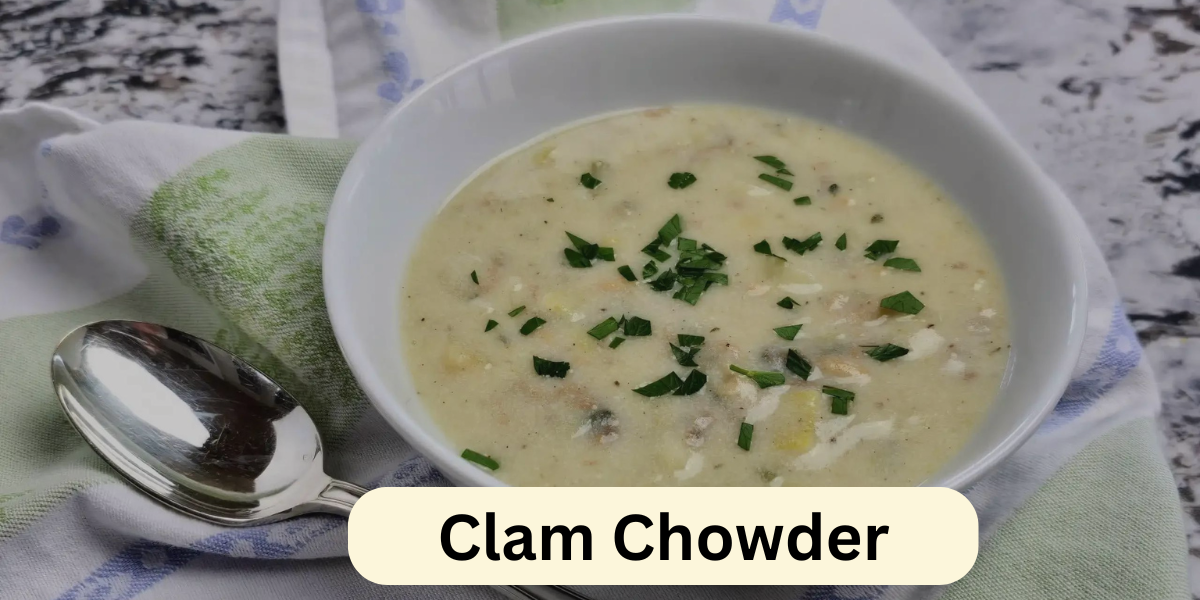Clam chowder, a creamy and hearty soup, has long been a staple of coastal American cuisine. This beloved dish is synonymous with comfort, evoking images of cozy seaside inns and bustling seafood shacks. While it may appear simple, clam chowder’s rich history, regional variations, and complex flavors make it a fascinating subject worthy of exploration. In this article, we delve into the origins of clam chowder, its different styles, how it’s made, and its place in contemporary cuisine.
Origins of Clam Chowder
The origins of clam chowder can be traced back to the early 18th century in the Northeastern United States, particularly New England. European settlers, including the French, English, and Portuguese, brought with them a tradition of making hearty stews and soups. They adapted these recipes to the ingredients available in the New World, with clams being abundant along the New England coast.
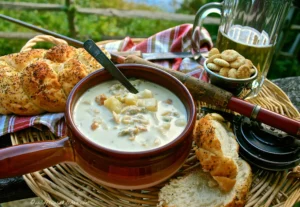
The word “chowder” is believed to derive from the French word “Chaudière,” meaning a type of cooking pot used to make stews. The original clam chowder was likely a simple dish made with clams, salt pork, onions, and hardtack (a type of hard biscuit), all simmered together in water. Over time, potatoes and dairy were added, resulting in the creamy, flavorful chowder we know today.
New England Clam Chowder
When most people think of clam chowder, they envision New England clam chowder. This classic version is characterized by its creamy base and thick, hearty texture. The ingredients typically include clams, potatoes, onions, salt pork or bacon, and heavy cream or milk. The use of dairy gives the chowder its signature richness, while the potatoes add substance and texture.
Watch Full Video:-
How to Make New England Clam Chowder:
Ingredients:
- 4 slices of bacon, diced
- 1 onion, finely chopped
- 2 celery stalks, finely chopped
- 3 cups diced potatoes (Yukon Gold or Russet)
- 2 cups clam juice
- 2 cups heavy cream or half-and-half
- 2 cans (6.5 ounces each) chopped clams, with juice
- 1 bay leaf
- Salt and black pepper to taste
- Fresh parsley, chopped (for garnish)
Instructions:
- In a large pot, cook the diced bacon over medium heat until crispy. Remove the bacon and set aside, leaving the rendered fat in the pot.
- Add the chopped onion and celery to the pot and sauté until soft, about 5 minutes.
- Add the diced potatoes, clam juice, and bay leaf. Bring to a boil, then reduce heat and simmer until the potatoes are tender, about 15 minutes.
- Stir in the heavy cream or half-and-half and the chopped clams with their juice. Heat through but do not let it boil.
- Season with salt and black pepper to taste. Remove the bay leaf.
- Serve hot, garnished with crispy bacon and chopped parsley.

Manhattan Clam Chowder
Manhattan clam chowder offers a distinctly different take on this classic soup. Unlike its creamy New England counterpart, Manhattan clam chowder has a clear broth base made with tomatoes. This version is lighter and more broth-like, featuring the same key ingredients: clams, potatoes, and onions, but with the addition of tomatoes and often bell peppers.
How to Make Manhattan Clam Chowder:
Ingredients:
- 4 slices of bacon, diced
- 1 onion, finely chopped
- 2 celery stalks, finely chopped
- 1 green bell pepper, finely chopped
- 3 cups diced potatoes (Yukon Gold or Russet)
- 2 cups clam juice
- 1 can (14.5 ounces) diced tomatoes
- 2 cans (6.5 ounces each) chopped clams, with juice
- 1 bay leaf
- 1 teaspoon dried thyme
- Salt and black pepper to taste
- Fresh parsley, chopped (for garnish)
Instructions:
- In a large pot, cook the diced bacon over medium heat until crispy. Remove the bacon and set aside, leaving the rendered fat in the pot.
- Add the chopped onion, celery, and bell pepper to the pot and sauté until soft, about 5 minutes.
- Add the diced potatoes, clam juice, diced tomatoes, bay leaf, and dried thyme. Bring to a boil, then reduce heat and simmer until the potatoes are tender, about 15 minutes.
- Stir in the chopped clams with their juice. Heat through but do not let it boil.
- Season with salt and black pepper to taste. Remove the bay leaf.
- Serve hot, garnished with crispy bacon and chopped parsley.
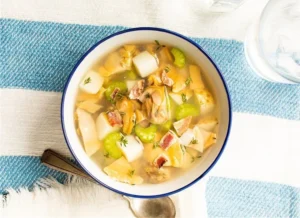
Rhode Island Clam Chowder
Rhode Island clam chowder is another regional variation that offers a unique twist. It is distinguished by its clear broth, which allows the flavors of the clams and other ingredients to shine through without the richness of cream or tomatoes. This version is particularly popular in Rhode Island and parts of Southern New England.
How to Make Rhode Island Clam Chowder:
Ingredients:
- 4 slices of bacon, diced
- 1 onion, finely chopped
- 2 celery stalks, finely chopped
- 3 cups diced potatoes (Yukon Gold or Russet)
- 2 cups clam juice
- 2 cans (6.5 ounces each) chopped clams, with juice
- 1 bay leaf
- Salt and black pepper to taste
- Fresh parsley, chopped (for garnish)
Instructions:
- In a large pot, cook the diced bacon over medium heat until crispy. Remove the bacon and set aside, leaving the rendered fat in the pot.
- Add the chopped onion and celery to the pot and sauté until soft, about 5 minutes.
- Add the diced potatoes, clam juice, and bay leaf. Bring to a boil, then reduce heat and simmer until the potatoes are tender, about 15 minutes.
- Stir in the chopped clams with their juice. Heat through but do not let it boil.
- Season with salt and black pepper to taste. Remove the bay leaf.
- Serve hot, garnished with crispy bacon and chopped parsley.

The Cultural Significance of Clam Chowder
Clam chowder holds a special place in American culinary culture, particularly in New England. It is a dish that evokes a sense of nostalgia and comfort, often associated with family gatherings, seaside vacations, and local traditions. Many coastal towns and cities in New England host annual chowder festivals, where chefs and home cooks compete to see who can create the best version of this beloved dish.
One of the most famous chowder traditions is the “Friday Clam Chowder” served at many restaurants in New England. Historically, Catholics abstained from meat on Fridays, leading to the popularity of seafood dishes like clam chowder. This tradition continues today, with many New Englanders enjoying a bowl of chowder as part of their Friday meals.
Clam Chowder in Contemporary Cuisine
While traditional clam chowder recipes remain popular, contemporary chefs have put their own spin on this classic dish. Modern variations may include ingredients like corn, leeks, or fennel for added depth of flavor. Some chefs experiment with different types of seafood, such as adding shrimp or lobster to the chowder.
Vegan and gluten-free versions of clam chowder have also emerged, catering to dietary restrictions while preserving the essence of the dish. These adaptations often use coconut milk or cashew cream as a substitute for dairy and include plant-based ingredients like mushrooms or tofu to mimic the texture of clams.
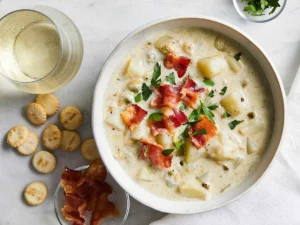
Making Clam Chowder at Home
Making clam chowder at home is a rewarding experience that allows you to customize the flavors and ingredients to your liking. Here are some tips to ensure your chowder turns out delicious:
- Use Fresh Clams: If possible, use fresh clams for the best flavor. Steaming fresh clams and using their broth will elevate your chowder. If fresh clams are not available, high-quality canned clams are a good alternative.
- Don’t Overcook the Clams: Clams can become tough and rubbery if overcooked. Add them to the chowder towards the end of the cooking process to ensure they remain tender.
- Balance the Flavors: Taste your chowder as you cook and adjust the seasoning as needed. The flavors of bacon, clams, and vegetables should complement each other without overpowering.
- Serve with Fresh Bread: Clam chowder is best enjoyed with a side of fresh, crusty bread or oyster crackers to soak up the delicious broth.
- Garnish Thoughtfully: A sprinkle of fresh herbs, such as parsley or chives, adds a bright note to the rich chowder and enhances its presentation.
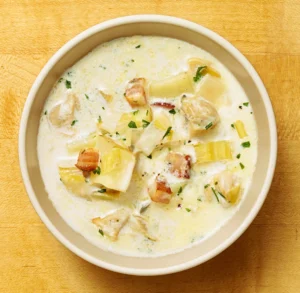
FAQs:-
1. What is clam chowder?
Clam chowder is a type of soup made with clams, broth, and various ingredients such as potatoes, onions, and often bacon or salt pork. It comes in several regional variations, including creamy New England clam chowder and tomato-based Manhattan clam chowder.
2. What are the different types of clam chowder?
The main types of clam chowder are:
- New England Clam Chowder: Creamy and thick, made with dairy, potatoes, onions, and clams.
- Manhattan Clam Chowder: Tomato-based and broth-like, including clams, potatoes, onions, and bell peppers.
- Rhode Island Clam Chowder: Clear broth-based, focusing on the natural flavors of clams and vegetables without dairy or tomatoes.
3. How do you make clam chowder?
Clam chowder is typically made by sautéing ingredients like bacon, onions, and celery, then adding potatoes, clam juice, and clams. New England clam chowder includes cream or milk, while Manhattan clam chowder uses tomatoes. The chowder is simmered until the flavors meld and the potatoes are tender.
4. Can I use canned clams for clam chowder?
Yes, canned clams are a convenient alternative to fresh clams and work well in clam chowder. Be sure to include the clam juice from the can to enhance the flavor of the soup.
5. Is clam chowder healthy?
Clam chowder can be part of a balanced diet, but its nutritional content varies by recipe. New England clam chowder is higher in calories and fat due to the cream, while Manhattan clam chowder is lighter. Moderation and portion control are key.
6. Can I make clam chowder without dairy?
Yes, you can make dairy-free clam chowder by substituting coconut milk, almond milk, or cashew cream for the dairy in New England clam chowder. There are also clear broth-based versions like Rhode Island clam chowder.
7. What are some common variations of clam chowder?
Common variations include adding corn, leeks, or fennel for extra flavor. Some recipes incorporate different types of seafood like shrimp or lobster. Vegan versions use plant-based ingredients to replace clams and dairy.
8. How should clam chowder be stored?
Clam chowder should be stored in an airtight container in the refrigerator and consumed within 3-4 days. It can also be frozen for up to 3 months, though the texture of the dairy-based versions may change slightly upon reheating.
9. What should I serve with clam chowder?
Clam chowder is often served with crusty bread, oyster crackers, or a side salad. Some people enjoy it with a splash of hot sauce or a sprinkle of fresh herbs like parsley or chives.
10. Where did clam chowder originate?
Clam chowder originated in the Northeastern United States in the early 18th century. It was influenced by European settlers’ traditions of making hearty stews and adapted to include local ingredients like clams.
Conclusion
Clam chowder, with its rich history and comforting flavors, continues to be a cherished dish in American cuisine. Whether you prefer the creamy New England version, the tomato-based Manhattan style, or the clear broth of Rhode Island chowder, there is a clam chowder recipe to suit every palate. By understanding the origins and variations of this timeless dish, you can appreciate its cultural significance and enjoy making and savoring it in your own kitchen.
ALSO READ:-Bacon: The Irresistible Allure of a Culinary Delight

